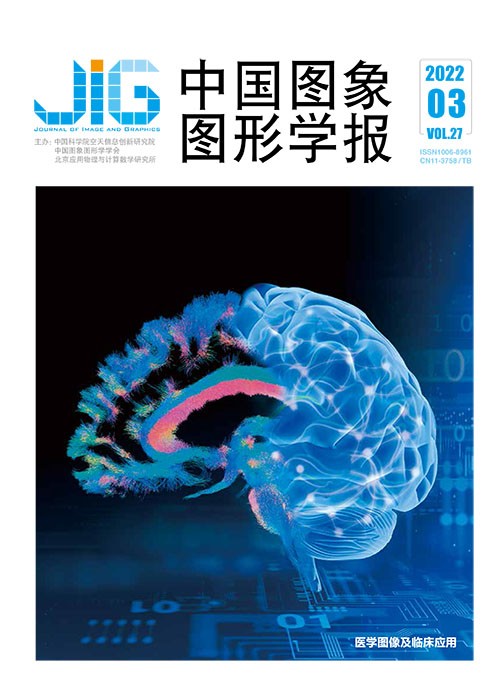
基础信息保持和细节强化的胸部CT图像增强
摘 要
目的 清晰的胸部计算机断层扫描(computed tomography,CT)图像有助于医生准确诊断肺部相关疾病,但受成像设备、条件等因素的限制,扫描得到的CT图像质量有时会不尽如人意。因此,本文提出一种简单有效的基于基础信息保持和细节强化的胸部CT图像增强算法。方法 利用多尺度引导滤波器将胸部CT图像分解为一个基础信息层和多个不同尺度的细节层。基于熵的权重将胸部CT图像的多个细节层进行融合,并乘以强化系数进一步增强纹理细节。将强化的细节层和原始的基础信息层重新组合即可生成细节强化的胸部CT图像。通过此种增强方式,本文算法既能显著增强胸部CT图像的纹理细节,又能将大部分原始的基础结构信息保留到增强图像中。结果 为了验证算法的有效性,将本文算法与5种优秀的图像增强算法在由3 209幅胸部CT图像组成的数据集上进行测试评估。定性和定量实验结果表明,本文算法得到的增强图像保持了更多原始胸部CT图像中的基础结构信息,并更显著地强化了其中的纹理细节信息。在定量结果中,本文算法的标准差、结构相似性和峰值信噪比指标值均优于对比的5种方法,相比于性能第2的方法分别提高了4.95、0.16和4.47,即分别提升了5.61%、17.00%和16.17%。此外,本文算法增强一幅CT图像仅消耗0.10 s,有潜力应用于实际的临床诊断中。结论 本文算法可以在保留大量原始结构信息的同时有效强化CT图像的细节信息,有助于医生对患者肺部疾病的精确诊断。本文算法具有较好的泛化能力,可以用于增强其他部位的CT图像和其他模态图像并取得优秀的增强结果。
关键词
Human chest CT image enhancement based on basic information preservation and detail enhancement
Zhang Yu1, Zhang Shunli2, Bai Xiangzhi1, Zhang Li3(1.School of Astronautics, Beihang University, Beijing 100191, China;2.School of Software Engineering, Beijing Jiaotong University, Beijing 100044, China;3.Department of Electronic Engineering, Tsinghua University, Beijing 100084, China) Abstract
Objective Human chest computed tomography (CT) image analysis is a key measure for diagnosing human lung diseases. However, the current scanned chest CT images might not meet the requirement of diagnosing lung diseases accurately. Medical image enhancement is an effective technique to improve the image quality and has been used in many clinical applications, such as knee joint disease detection, breast lesion segmentation and corona virus disease 2019(COVID-19) detection. Developing new enhancement algorithms is essential to improve the quality of chest CT images. A simple yet effective chest CT image enhancement algorithm is presented based on basic information preservation and detail enhancement. Method A good chest CT image enhancement algorithm should well improve the clarity of edges or speckles in the image, while preserving much original structural information. Our human chest CT image enhancement algorithm is developed as follows. First, this algorithm exploits the advanced guided filter to decompose the CT image into multiple layers, including a base layer and multiple different scales of detail layers. Next, an entropy-based weight strategy is adopted to fuse the detail layers, which could well strengthen the informative details and suppress the texture-less layers. Afterwards, the fused detail layer is further strengthened based on an enhancement coefficient. In the end, the enhanced detail layer and the original base layer are integrated to generate the targeted chest CT image. The proposed algorithm could well enhance the details of the chest CT image, as well as transfer much original basic structural information to the enhanced image. Moreover, with the help of our algorithm, the surgeons can inspect more clear medical images without impacting their perception of the pathology information. In order to verify the effectiveness of our proposed algorithm, we have constructed a chest CT image dataset, which is composed of 20 sets/3 209 chest CT images, and then evaluated our algorithm and five state-of-the-art image enhancement algorithms on this large-scale dataset. In addition, the experiments are performed in both qualitative and quantitative ways. Result Two qualitative comparison cases demonstrate that our algorithm has mainly strengthened the useful details, while effectively suppressing the background information. As for the five comparison algorithms, histogram equalization(HE) and contrast limited adaptive histogram equalization(CLAHE) usually change the whole image intensities with large variation and degrade the image quality as compared to the original image. Alternative toggle operator(AO) could enhance the chest CT image with much better visual quality than HE and CLAHE, but it has excessively enhanced both image details and background noises. Low-light image enhancement(LIME) and robust retinex model(RRM) usually increase the intensities of the whole image and result in images of inappropriate contrast. The quantitative average standard deviation(STD), structural similarity metric(SSIM), peak signal to noise ratio(PSNR) values of our algorithm are significantly greater than those of the other five comparison algorithms (i.e., increased by 4.95, 0.16, 4.47, respectively) on our constructed chest CT image dataset. To be specific, greater average STD value of our algorithm indicates it has enhanced images with more clear details compared to the other five comparison algorithms. Larger average SSIM and PSNR values of our algorithm validate that it has preserved more basic structural information from the original image than the other five comparison algorithms. Meanwhile, the proposed algorithm only costs about 0.10 seconds to enhance a single CT image, which indicates the proposed algorithm has great potential to be efficiently applied in the real clinical scenarios. Overall, our algorithm achieves the best results amongst all the six image enhancement algorithms in terms of both visual quality and quantitative metrics. Conclusion In this study, we have developed a simple yet effective human chest CT image enhancement algorithm, which can effectively enhance the textural details of chest CT images while preserving a large amount of original basic structural information. With the help of our enhanced human chest CT images, the surgeons could diagnose lung diseases more accurately. Moreover, the proposed algorithm owns good generalization ability, and is capable of well enhancing CT images scanned from other sites and even other modalities of images.
Keywords
diagnosis of lung diseases chest CT image enhancement image decomposition basic information preservation detail enhancement
|



 中国图象图形学报 │ 京ICP备05080539号-4 │ 本系统由
中国图象图形学报 │ 京ICP备05080539号-4 │ 本系统由